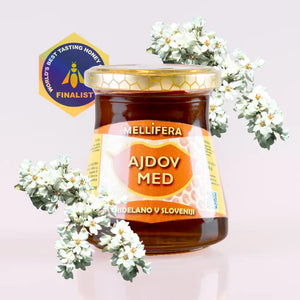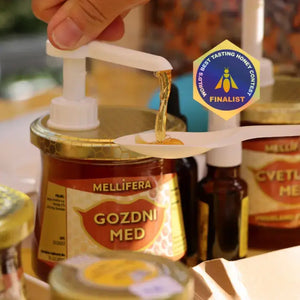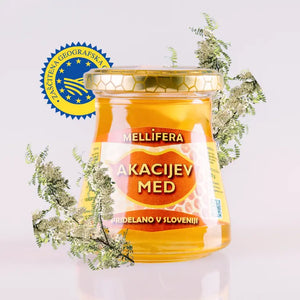
Beekeeping is considered one of the oldest and most natural forms of human activity. Over the centuries, it has evolved into a carefully planned process that combines an understanding of bee biology, knowledge of nature, and the timely use of appropriate equipment. Below are the basic tasks and steps required for successful honey production.
1. Regular inspections of bee colonies
During the period of active bee development, which lasts from early spring to late autumn, the hive is usually inspected every seven to ten days.
This ensures continuous monitoring of the health of the colonies and their readiness for the honey season.
- Brood control: The presence of eggs, larvae and covered brood is checked, which indicates the proper functioning of the queen. A healthy queen broods evenly, thus ensuring a balanced development of the colony.
- Food reserve status: The supply of honey and pollen should always be sufficient. If there is a shortage, the bees should be fed in a timely manner, especially before prolonged dry periods or at the end of the season.
- Removing old combs: Over the years, combs darken and accumulate debris that can increase the risk of disease. It is recommended to gradually remove old combs and replace them with new ones.
Regular inspections also help in the early detection of any parasites or diseases and in maintaining the overall health of the hives.
2. Key equipment when working with bees
Sometimes our ancestors made do with a little smoke, wooden hammers and a simple cloth over their faces. Today, we are grateful for progress and new materials that make work even safer and more enjoyable. Despite everything, we try to maintain that home-grown approach that emphasizes respect for the bees.
 In beekeeping, the right equipment is as important as knowledge of the nature and behavior of bees. It ensures safe and efficient work, while maintaining peace in the apiary. The correct and regular use of this equipment contributes to successful and safe work in the apiary. Without proper equipment, working with bees would be challenging, and sometimes even dangerous.
In beekeeping, the right equipment is as important as knowledge of the nature and behavior of bees. It ensures safe and efficient work, while maintaining peace in the apiary. The correct and regular use of this equipment contributes to successful and safe work in the apiary. Without proper equipment, working with bees would be challenging, and sometimes even dangerous.
- Beekeeper's hat or headgear with veil: Come sun or rain, a hat is with us every time we look into the hive. When my grandfather wore his hat with a veil, he always said: “Keep your head calm and safe, so that the work will be calm.” This proverb still resonates in my mind today – we approach the bees calmly and with a smile.
- Beekeeper's smoker (chimney): The smoke calms the bees, so a smoker is indispensable during every inspection. Natural materials such as dry grass, wood shavings or special briquettes can be burned.
- Protective gloves: Often made of leather or another durable material and extending over the wrists, they provide more confidence for beginners, while more experienced users use them as needed.
- Tool for opening the hive and lifting combs: With a special metal rod and knife, it is easy to separate stuck parts of the hive and safely lift or move combs.
- Broom/Brush: Used to gently remove bees from combs when necessary for inspection or relocation. A soft brush will not injure or disturb the bees.
3. Honey season and honey harvesting
When the acacias bloom, when the linden tree gives off its fragrance, or when we detect the scent of honey in the forest, we know that the most magical part of the year is upon us. Bees fly across the surrounding meadows and forests, and we watch as their efforts turn into precious honey.

When bee colonies are strong enough and find an abundance of pollen and honey in nature, honey-making time sets in. This is the period when bees accumulate the most reserves and create delicious types of honey.
- Choosing the right combs: For a specific type of honey (floral, forest, linden, etc.), it is important to choose combs where the honey is already sufficiently mature. It is often considered that at least two-thirds of the comb should be covered with wax caps.
- Opening the combs and pouring: The comb lids are carefully removed with a special knife or fork, and the honey is then extracted with a pourer. Centrifugal force pushes the honey from the comb cells to the walls of the pourer and collects it at the bottom.
- Storing honey: It is recommended to store honey in sterile and hermetically sealed containers, in a room with moderate temperature and low humidity. This way it preserves its natural quality, taste and aroma.
We always say that pouring honey is the best "beekeeping holiday," because in one single step you get to taste all the effort you and the bees have put in over the previous months.
4. Caring for bee pasture and the environment
Every beekeeper knows that bees thrive not only thanks to good hives and equipment, but above all due to proper grazing. High-quality honey is closely linked to a diverse and rich bee pasture.
Bees need honey from various plants, so landscaping or choosing a suitable location for hives is extremely important.
- Planting honey plants: Buckwheat, thyme, lavender, and other flowering plants contribute to greater food diversity and greater stability of bee colonies throughout the season.
- Pest management: Wasps, hornets, and other pests that can attack bee colonies should be dealt with using ecological methods and with care to avoid harming beneficial organisms.
- Organic beekeeping: Natural methods of disease control are increasingly being used, thus maintaining balance in the apiary and ensuring a higher quality of the final honey harvest.
A thoughtful approach to the environment greatly contributes to the long-term health of bees, while also promoting biodiversity in nature.
Conclusion
Honey production is a combination of careful observation of bees, proper use of equipment, respect for nature and its cycles. By constantly caring for the health of the bees, providing a varied diet and hygiene in the apiary, strong and productive colonies are maintained. The result of this work is high-quality honey, full of aromas and rich flavors, which has been valued for centuries as one of the most valuable natural foods.
Would you like to try our freshly pressed honey?
Contact us or visit our online store, where you can choose from different varieties and see for yourself why it is considered one of the most valuable natural products. Click here for the online store.





